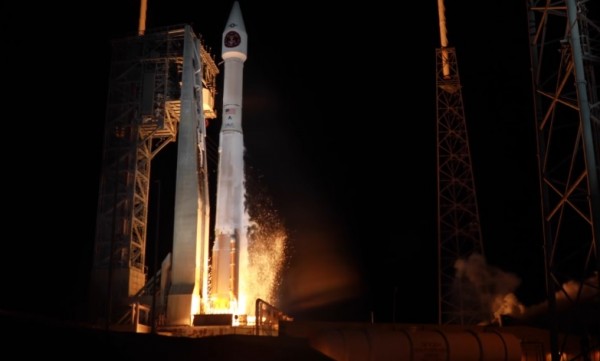By Ana Verayo, | January 21, 2017

SBIRS GEO Flight 3 takes off from Cape Canaveral Air Force Station, Florida, at 7:42 p.m. EST on Jan. 20. (United Launch Alliance Youtube)
A U.S. military rocket successfully launched a missile warning satellite from the Cape Canaveral Air Force Station on Friday, January 20.
The launch of the Atlas V rocket was rescheduled to Friday after weather forecasts revealed more favorable conditions, according to officials from the U.S. Air Force. The powerful rocket was launched from Cape Canaveral Air Force Station's Space Launch Complex 41.
Like Us on Facebook
The rocket, which was developed by the United Launch Alliance, is set to place a military early warning missile satellite into orbit for the U.S. Air Force. This satellite is also a crucial step in returning manned space launches back to Cape Canaveral in Florida.
This satellite is known as the SBIRS (Space-Based Infrared System) by Lockheed Martin and was aboard the Atlas V rocket that launched from the Atlantic coast.
The launch was initially scheduled for Thursday. Mission engineers noticed something flying as another aircraft was within the launch pad area and ordered the lift off to be stopped.
On Friday, officials allowed a 40-minute launch window due to initial delays.
The SBIRS satellite aims to improve military defense capabilities, missile warnings, and technical intelligence as well as space mission launch technologies and navigation systems.
The SBIRS was completed on January 7. It is fitted with powerful sensors that can scan any region on the planet and transmit surveillance data via infrared quickly to ground stations.
The SBIRS is also third satellite from the SBIRS system to be launched into lower Earth orbit. The fourth satellite is scheduled to be launched later this year. Two additional satellites are under development.
According to David Sheridan of Lockheed Martin's Overhead Persistent Infrared (OPIR) systems, following this successful launch, the first critical step was to acquire a signal. With communications now established, the SBIRS will be placed in its final orbit, and the U.S. Air Force can complete deployments and operational testings before it begins its missions.
-
Use of Coronavirus Pandemic Drones Raises Privacy Concerns: Drones Spread Fear, Local Officials Say

-
Coronavirus Hampers The Delivery Of Lockheed Martin F-35 Stealth Fighters For 2020

-
Instagram Speeds Up Plans to Add Account Memorialization Feature Due to COVID-19 Deaths

-
NASA: Perseverance Plans to Bring 'Mars Rock' to Earth in 2031

-
600 Dead And 3,000 In The Hospital as Iranians Believed Drinking High-Concentrations of Alcohol Can Cure The Coronavirus

-
600 Dead And 3,000 In The Hospital as Iranians Believed Drinking High-Concentrations of Alcohol Can Cure The Coronavirus

-
COVID-19: Doctors, Nurses Use Virtual Reality to Learn New Skills in Treating Coronavirus Patients









